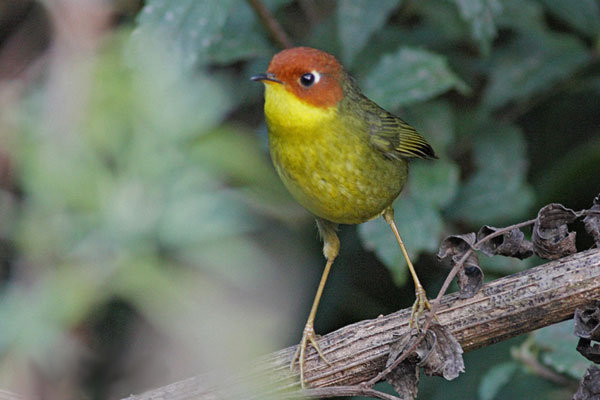- Tesia
Taxobox
name = Tesia

image_caption =Chestnut-Headed Tesia
image_width = 240px
regnum =Animalia
phylum =Chordata
classis =Aves
ordo =Passeriformes
familia =Cettiidae
genus = "Tesia"
genus_authority = Hodgson 1837The tesias are a genus, "Tesia", ofOld World warbler . The genus was once included in the large familySylviidae but recent research placed it within the new familyCettiidae . [Alström, P.; Ericson, P.G.P.; Olsson, U. & Sundberg, P. (2006): Phylogeny and classification of the avian superfamily Sylvioidea. "Mol. Phylogenet. Evol." 38(2): 381–397. doi|10.1016/j.ympev.2005.05.015 ] The genus has a discontinuous distribution in East and South East Asia. The three northern species range widely across southern China, Burma, Northern Thailand and Laos and into India, southern Nepal and Vietnam; whereas the other two species are found inJava and theLesser Sundas in southernIndonesia . One species of tesia, theChestnut-headed Tesia , which occupies the northern area of the genus' range, is sometimes split into the genus "Oligura". TheRusset-capped Tesia was once considered to be a race of theTimor Stubtail , "Urosphena subulata". The three northern species are sometimes known as ground-warblers.Tesias are tiny ground-living warblers which range in length from 7-10 cm and weigh between 6-12 g. Franz Bairlein, Per Alström, Raül Aymí, Peter Clement, Andrzej Dyrcz, Gabriel Gargallo, Frank Hawkins, Steve Madge, David Pearson & Lars Svensson "Family Sylviidae (Old World Warblers)" "in" del Hoyo, J.; Elliot, A. & Christie D. (editors). (2006). "
Handbook of the Birds of the World ." Volume 11: Old World Flycatchers to Old World Warblers. Lynx Edicions. ISBN 849655306X.] They have long legs and an upright stance, and appear to almost lack a tail, as their tail retrices are shorter than the tail coverts.Captain J. Delacour (1942) "The Bush-Warblers of the Genera Cettia and Bradypterus, with Notes on Allied Genera and Species". "Ibis" 84 (4): 509-519, doi|10.1111/j.1474-919X.1942.tb03450.x] Theplumage of the northern species (except the Chestnut-headed) is olive backs and wings and grey bellies (darker slate in theSlaty-bellied Tesia ); the southern species have brown wings and backs. All species have an eye-stripe and all except the Slaty-bellied Tesia have a supercillium; this is most prominent in theJavan Tesia . The plumage of the Chestnut-headed Tesia is different from the other species; it has a bright yellow belly, chest and throat, and a deep chestnut coloured head and an incomplete white orbital ring. It lacks the facial stripes of the other species. The bill of all species is long and bicoloured, with a dark upper mandible and a flesh-coloured lower one, as well as strong ridge on the upper mandible.Tesias live in the undergrowth of forest, usually montane broadleaf forest. They have a preference for damp forests, and are often found near water, particularly the Chestnut-headed and Slaty-bellied Tesias, although they use a range of microhabitats within the forest, including patches of bamboo or nettles. The three northern species are altitudinal migrants, breeding up to 4000 m but wintering as low as 150 m. The two southern species are resident within their range.
The tesias are active insectivores that usually feed near the ground amongst the undergrowth and leaf litter, but may forage as high as 25 m off the ground (in the case of the
Russet-capped Tesia ) amongst the tangle of creepers on large tree trunks. The Slaty-bellied Tesia will move leaves around in the manner of a thrush while foraging, and theGrey-bellied Tesia has been recorded joiningmixed-species feeding flock s in the non-breeding season.There is little information about the breeding biology of the tesias, only three species, the Grey-bellied, Chestnut-headed and Javan, have even had their nests described. They are seasonal breeders, with the Grey-bellied and Russet-capped Tesias nesting in May-July, and the Javan Tesia having two seasons, April-June and October to December. The nest is a ball of moss for the Grey-bellied Tesia and plant fibres, moss and roots, and is fixed into vegetation or moss on the side of a tree, low down. The clutch size of the Grey-bellied Tesia is 3-5 eggs, but only 2 eggs for the Javan Tesia and Chestnut-headed Tesia. In the Chestnut-headed Tesia both sexes incubate the clutch; this species is also known to occasionally be parasitized by the
Lesser Cuckoo .None of the tesias are considered to be
threatened by human activities, and are all listed asleast concern by theIUCN . Even the island species, which have restricted ranges, are described as common within their ranges. [IUCN (2007). [http://www.iucnredlist.org/search/search.php?freetext=Tesia&modifier=phrase&criteria=wholedb&taxa_species=1&redlistCategory%5B%5D=all&country%5B%5D=all&cty_default=1&aquatic%5B%5D=all&aqu_default=1®ions%5B%5D=all®_default=1&habitats%5B%5D=all&threats%5B%5D=all&redlistAssessyear%5B%5D=all&growths%5B%5D=all2007 IUCN Red List of Threatened Species: "Tesia"] .. Downloaded on 27 April 2008. ]pecies
*
Chestnut-Headed Tesia ("Tesia castaneocoronata")
*Slaty-Bellied Tesia ("Tesia olivea")
*Grey-Bellied Tesia ("Tesia cyaniventer")
*Javan Tesia ("Tesia superciliaris")
*Russet-Capped Tesia ("Tesia everetti")References
Wikimedia Foundation. 2010.
